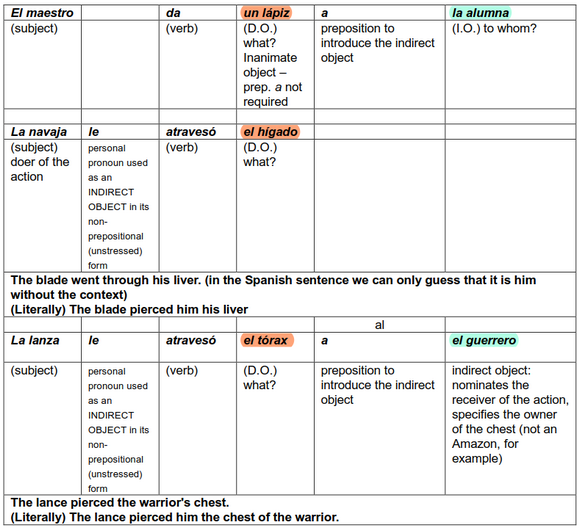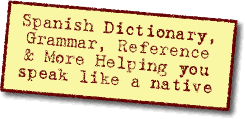Ask a Question(Create a thread) |
|
|||||||
Direct and Indirect Objects in the Spanish SentenceThis is the place for questions about conjugations, verb tenses, adverbs, adjectives, word order, syntax and other grammar questions for English or Spanish. |
 |
|
|
Thread Tools | Display Modes |
|
#1
|
||||
|
||||
|
Direct and Indirect Objects in the Spanish Sentence
I have been figuring out the relation between the direct and the indirect objects in the Spanish sentence. The chart below represents my rough understanding of the matter.
Would you suggest any approaches to internalizing the relation more efficiently? Of a particular concern is the need to put the unstressed form of the personal pronoun in preposition to the verb. Thank you. 
Last edited by Nfqufktc; April 08, 2024 at 05:42 AM. |
|
#2
|
||||
|
||||
|
The direct object pronoun and/or the indirect object pronoun actually have preferred positions in a sentence, greatly driven by the form of the verb.
In your examples, placing the object pronouns prior to a conjugated verb is preferred. When an infinitive, imperative, or a gerundio appears in a sentence, the object pronouns are usually suffixed. When suffixing object pronouns, an accent mark is often needed to maintain proper stress of the infinitive, imperative, or gerundio. Have a look at what others have said about these preferences here and here. Not every region of the Spanish-speaking world is in accordance about the usage of the object pronouns. You'll soon discover leísmo, loísmo, and laísmo prevails in certain places. You'll also hear about the 'le' de cortesía. The important thing to remember is that you should learn correct practices, even though "correct" can vary from region to region, and then adapt to those around you whose speech varies from the norm. |
|
#3
|
||||
|
||||
|
Thank you. I will follow the recommended links.
Last edited by Nfqufktc; April 08, 2024 at 08:33 AM. |
|
#4
|
||||
|
||||
|
Let me rephrase my question in this post as what I asked you is just a detail in the broader picture.
Are you aware of or would you recommend any reference guide to the verb patterns in the Spanish language that is similar to the Guide to Patterns and Usage in English by A.S. Horby? It would be nice having a chart for a quick look-up. 
Last edited by Nfqufktc; April 09, 2024 at 10:58 PM. |
|
#5
|
||||
|
||||
|
I don't think I've ever seen an equivalent, but you might find useful these notes on the usage of DO and IO pronouns by the Academia.

__________________
♪ ♫ ♪ Ain't it wonderful to be alive when the Rock'n'Roll plays... ♪ ♫ ♪ |
|
#6
|
||||
|
||||
|
Thank you for the suggestion but that's not what I have in mind
|
|
#7
|
||||
|
||||
|
The Guide to Patterns and Usage in English you posted is something I've never encountered before. There are some Spanish Verb books that are cited here in the forums, one of which is Barron's 501 Spanish Verbs. But I'm not aware of any book that provides sentence patterns for every verb.
Barron does a great job of providing very useful conjugation charts, and even lists over 2000 other verbs that are conjugated the same way as the 501 model verbs. But how objects (direct, indirect, prepositional) and other parts of speech should be used with particular verbs is something I've not ever seen in any one place. Sorry. One thing is for certain, there's no need to memorize every verb (and its almost 100 conjugations). Tackling the irregular verbs can be quite intimidating (Barron's and other sources present a large number of them), but it seems you would expect irregularities after learning English. The Academy is an excellent source, but for only a single verb at a time. |
|
#8
|
||||
|
||||
|
Thank you for the recommendation.
I am striving to discern patterns. The Guide to Patterns and Usage in English has proven a useful resource in studying English. As for finding out the patterns of the Spanish sentence, WordReference.com can be of some help. Last edited by Nfqufktc; April 10, 2024 at 10:11 AM. |
|
#9
|
||||
|
||||
|
Action verbs are almost always listed as transitive or intransitive, depending on your source. WordReference.com certainly does. It also hints at what prepositions a verb may work with.
These indicators will help you to know if a direct object is expected or not. As mentioned, direct objects have preferred placement, as do the direct object pronouns, depending on the mood (or verb form). Some verbs take both a direct and an indirect object, like 'dar', whose model is «darle algo a alguien». 'Algo' corresponds to the direct object; 'a alguien', the indirect object; and 'le', the indirect object pronoun. The pronoun is suffixed to an infinitive, imperative, or gerundio. I try to learn every verb with its model. |
|
#10
|
||||
|
||||
|
Thank you again. That is exactly what I mean. But, unfortunately, no short cuts here. The job of marshalling verbs into patterns is mine.
|
 |
«
Previous Thread
|
Next Thread
»
| Link to this thread | |
|
|
|||||||
 Similar Threads
Similar Threads
|
||||
| Thread | Thread Starter | Forum | Replies | Last Post |
| Can you help me with Spanish direct and indirect object pronouns? | spanishmom | Practice & Homework | 5 | May 13, 2012 05:00 PM |
| Pronouns - direct and indirect objects | wattspamela31 | Practice & Homework | 2 | February 29, 2012 11:19 AM |
| Identifying the direct and indirect objects | pia | Practice & Homework | 7 | April 12, 2011 07:21 PM |
| Direct and Indirect Objects Word Order | FrannyCakes | Grammar | 6 | July 11, 2009 04:27 PM |
| Tenses, Direct and Indirect Objects, Articles, Oh My! | AutumnBreeze | Teaching and Learning Techniques | 22 | June 16, 2009 12:14 PM |
All times are GMT -6. The time now is 12:25 AM.







 Linear Mode
Linear Mode

